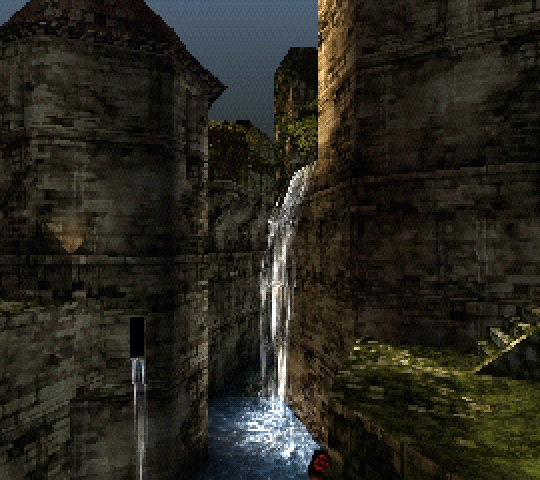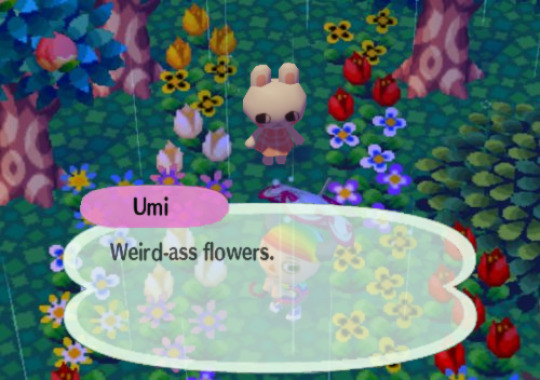Text
core memory 🐟 (song is animal crossing gc - igloo)
119 notes
·
View notes
Text
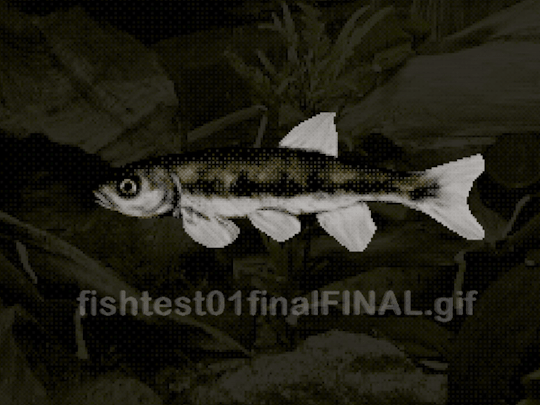
opened blender (uh oh) bc I wanted to test hand painting a fishy but realised I would prefer to do it a different way so didn't bother finishing the fins
123 notes
·
View notes
Text
INTERVIEW WITH SHIGENOBU MATSUYAMA - PRODUCER ON SILENT HILL THE ARCADE
I had the pleasure of interviewing Matsuyama-san, one of the producers on Silent Hill the Arcade! Here's what he had to say :)
Q - How did the idea for Silent Hill The Arcade come to be?
A - During the arcade boom of the 1990s and the 2000s, a desire was born to combine the unique worldview of the Silent Hill series - which was already a very strong IP console game-wise – with the haunted houses one might find in an amusement part. We wanted something that could provide an easy and pleasurable experience to an extremely varied range of customers… as in, the casual users. This is the idea that brought Silent Hill Arcade (SHA in short) to life. However, since our goal was to create a new kind of experience that could not be replicated anywhere else, we designed a game that could make the most effective use of the 5.1ch surround sound system, which was something that arcade games hadn’t adopted until that point, with a type of cabinet that could be somewhat isolated from the rest of the arcade via the use of curtains.
Q - Roughly how long did development for the game take?
A - At the time, the development cycle of an arcade game was so short it would be unimaginable today. The shortest one was around six months, the longest about one year and a half. I think SHA took us around one year and two months.
Q - What parts of development were most enjoyable for you?
A – Usually, arcade games are tested a certain number of times, both during development and just before launch in each and every country where their release has been scheduled (which, for SHA, meant Japan, the US, the UK, Italy, Spain, France, Hong Kong and Singapore). In order to keep the development budget for SHA as low as possible, however, I personally traveled alone to the US for the market testing, assembled the cabinet all by myself, repaired it when it was out of order, and stood next to it for days on end, pen and paper in my hand, ready to collect the players’ data. Game development, nearly 20 years ago, was very much an analog experience. It was also hard work, but when I look back, I have so many good memories of that time.
Q - Do you remember any kinds of ideas that you and the team wanted to include in the game, but didn’t in the end?
A – I’m sure this will sound obvious, since SHA was based on a pre-existing IP, but since the framework was pretty much already set when it came to characters and plot, we had to be extremely careful not to deviate from it so that we wouldn’t create inconsistencies. Personally, I would have loved to take the story in slightly wilder directions and include new and fresh ideas.
Q - I loved seeing so many locations from Silent Hill 3 and 4 make an appearance in the game! Was the team who worked on those two games involved in making any decisions for Silent Hill The Arcade?
A - We of course personally consulted select staff members of Konami, like for example Producer Yamaoka, with whom I had been acquainted with since before SHA. However, most development teams had a mix of internal and external members that changed pretty fluidly with each and every year, so there was no real collaboration between the various teams.
Q - What level of freedom were you given for creating this original story within the Silent Hill universe? Were you given any specific directives on what you could or could not integrate/use in the story?
A - If I have to express my personal point of view on the matter, however, should you compare the storyline for SHA with the timeline of the other games, you would indeed notice a few minor inconsistencies that we were not able to completely solve. That’s something I still have regrets about.
Q - Tell me about translating a traditional survival horror experience into the rail shooter genre and control style. What kind of considerations did you have to make for this?
A - The biggest challenge was by far to design a game system that could be as simple as possible, and to regulate the level of challenge in a way that felt balanced, because we didn't want to force complicated controls or an exceedingly high difficulty level on the casual arcade players. Moreover, there was another balance we had to strike perfectly: more specifically, the one between the aforementioned "haunted house" element - the one that was unique to SHA, with its sequences of terrifying events - and the thrilling playstyle that a rail shooter should provide to the player.
Q - As a final product, what are your personal thoughts on the game?
A - I think it had a state-of-the-art sound system, that the design of the cabinet, with its creepy-looking curtains, made people want to take a peek inside, and that the rail shooting system was simple and could be enjoyed by virtually everyone. I think we managed to combine these various elements with a one-of-a-kind worldview of Silent Hill in a way that was in my opinion pretty good! Of course, each and every member of the staff did their part, and I thank all of them wholeheartedly.
Q - Are you working on anything currently that you’d like me to mention?
A - Feel free to write whatever you prefer! If anything, I should thank you, since you allowed me to walk down the nostalgia lane and recall memories from almost 20 years ago that had been dimmed down by the passage of time. Thank you very much!
Shigenobu Matsuyama's site: shig.jp
40 notes
·
View notes
Text
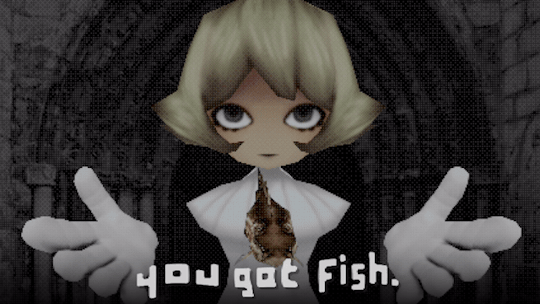

still have no idea what I'm doing but blender has been fun!!
28K notes
·
View notes
Text
INTERVIEW WITH TAKAYUKI YANAGIHORI - DIRECTOR ON PHASE PARADOX PS2
As I was researching the Japan exclusive PS2 game Phase Paradox (sequel to Philosoma on the PS1), I quickly realised there's very little information available on this sci-fi horror game. Thankfully, the director of Phase Paradox responded to me and I was able to learn more about this obscure title which I'd like to share!
Takayuki: First, let me introduce myself. I started my career as a game developer at Sega, then at SCE (now SIE) and Microsoft. After that, I started my own small studio and am still making games. This time I developed PHASEPARADOX, which was originally a survival horror game for PS1, but changed to an adventure game for PS2.
You mentioned to me that the game was difficult work, what parts of development were challenging? How many years did development take?
The most important thing is that it was an early PS2 title. There was a lack of development equipment, and it was difficult to tell whether bugs were caused by the program or the development equipment, and PS2 development itself was difficult. We also had to handle a large amount of CG, which was very difficult because it was still the 1990s and the CG tools and techniques were not yet up to scratch.
As for the development period, I was in charge for 4 years, but I heard that it took about 2 years before that. (I heard that the game had already been playable on PS1.)
In contrast, what parts of development were the most enjoyable for you?
Game development is always fun. Creating assets using 3DCG, which was the state-of-the-art at that time, building a worldview in accordance with science fiction research, setting scenarios and characters, etc., all of it was both painful and enjoyable.
I was inspired to try new things.
Were there any movies or video games that were a big influence for Phase Paradox? For example, Massimo's character reminded me a lot of Ron Perlman and Arnold Schwarzenegger!
The original idea was to create a "Resident Evil" game based on the world of the "ALIEN" movie. I incorporated a lot of my knowledge of game design and movies into the project.
As you said, the character of Massimo is Arnold Schwarzenegger, and Jude Sutcliffe is Michael Pare. All the other characters have Hollywood star models. I think it was allowed because it was then, but it is not now, lol. The game part was based on Movie Adventure.
The cast for the game is very impressive! Since the voices are in English, was the game planned for worldwide release?
Yes, it was supposed to be a big seller all over the world. However, it was cancelled due to the short playing time and the lack of gameplay. The voice recording was done in L.A.
The presidential election was taking place at the time of recording, and I remember the staff saying to me, "You are in the U.S. on a historic day”.
I love the design of the environments. There are many rooms (like the arcade) that have a very unique and detailed appearance. Did a lot of work go into creating the interior of the Gallant? What were some of the inspirations behind the designs?
The artwork was done by Matsushima-san, continuing from Philosoma. This person has experience working on costumes for the Ultraman series at Bandai, and he drew the foundation of the world, the art settings, and all the original drawings.
Phase Paradox is a sequel to Philosoma. Was it difficult to make a game with a fictional world and characters that were already established? Or did this make work easier?
As I mentioned in 5, it was not difficult for me to continue with Mr. Matsushima. Rather, I enjoyed it very much because I was allowed to add my favorite SF essence to Philosoma.
Do you remember any features that you and the team wanted to include in the game, but maybe couldn't because of time or cost?
Action game elements, mini-games, more options. I am very disappointed. But I think if we had included these elements, we would still be making them, lol. How many more years would have been needed?
At the time, we abandoned the idea of calculating or thinking about that number. We concentrated only on completing it.
What did you and the team want to achieve with Phase Paradox? It feels like a very "cinematic" game, was this rare with games at the time?
The result was a common movie game, but rather than a cinematic part of the game, we were aiming for an innovative adventure game where the situation changes depending on the choices you make.
I was aiming for something like "Detroit: Become Human", if I may say so now in the 21st century. Every time I play that game, I feel strongly about it.
As a final product, what are your personal thoughts on Phase Paradox?
It was a lousy performance, is all I can say. I have always regretted that it was worth it to spend so much money and market value to bring a game with only graphics to the world.
Is there anything else you'd like to share about working on the game? Any strong memories or interesting facts?
As I wrote in #8, I was aiming for a groundbreaking, new game, but I have nothing but regrets about developing on new hardware, not being able to devote the effort to gameplay due to my focus on graphics, and being buried and truncated in various ways by a large amount of work.
More than 20 years have passed and I have sealed my memory, but when I recall it like this, I feel more proud than ashamed, feeling that I was young and ambitious.
Thank you very much.
What are you working on currently?
I am currently making a soccer game at GADE inc.
One is a blockchain game. The other is a 3D action soccer game. I am working on both of them to get rid of my dissatisfaction and regret of the action soccer game I made in Sega.
I am proud to say that I still have new initiatives and high aspirations, so please look forward to them. Both are for the whole world. However, we are having a hard time because we don't have the money for promotion. We would be very happy if someone could help us. We are also planning to launch a new innovative adventure game service on the Web and an action game with an elaborate world view.
If anyone is interested or willing to support us, please contact us.
Thank you to Takayuki for taking the time to provide his insight into Phase Paradox's development! I've made a video on the game which you can watch here: https://youtu.be/bTSFY5M08BU
30 notes
·
View notes
Text
FORBIDDEN SIREN INTERVIEW WITH MIKI TAKAHASHI (CONCEPT ARTIST ON SIREN)
Thank you to Bokeh Game Studio and Miki Takahashi for taking the time to answer my questions!! I featured some of the answers in my latest video on the first Siren game, but here's the full interview for everyone to read:
1. What kind of directions did you receive when asked to design the Shibito? And what aspects of the designs in particular do you feel come from you and your style specifically?
2. How did you approach combining humans with sea creatures in the context of horror? I imagine you could take that idea but also end up making it look too cool or even quite funny, so how did you ensure they stayed creepy?
(Answering both 1 and 2)Regarding the combination of humans and sea creatures – as there was the aspect of the “Sea Sending” ritual in the story, the Art Director requested that sea creatures be incorporated into the Shibito’s design.
However, I preferred to detach myself from a traditional horror design. There are many monsters with decaying bodies, big mouths, fangs, and glaring eyes seen in other works. I also felt that if the creator’s intention of trying to intimidate viewers becomes too obvious, the result would be less interesting.
The Shibito is a physical manifestation of God’s blessing. They are not zombies, but rather bodies that are being reborn. This is why I incorporated the colors and shapes of lively, beautiful sea creatures in the design.
I also believe that ultimately in horror, there is a fine line between humor and pity. The final design was an outcome of pursuing this line.
3. What was your favourite Shibito design and why? Were there any particular Shibito concepts you made that you really liked but didn’t end up in the game?
I would say that Mina Onnda’s Shibito Brain is my favourite. This is the first Shibito I had designed, and I remember Toyama liking it. This therefore allowed the overall approach of the Shibito’s design to be clearer in my head.
4. Datatsushi’s appearance resembles a Shakoki-dogu. When it came to the design process, were the real-life counterparts the origin or starting point of a design? Or did they only come in during the later stages of creation to finalise details? I’m interested in how the relationship between reality and fiction worked during development!
Thank you for spotting the resemblance of the Shakoki-dogu! The design was inspired by the
beheading of Datatsushi. The reason for it… I think I will leave it up to your imagination.
5. What did you learn from your time working on the first Siren game? Are there any particular memories you’d like to share?
Through thoroughly incorporating the world and atmosphere of the game, I discovered how rewarding it is to create a convincing design. I find that the stories and settings that aren’t present on-screen are the most important aspects. I believe these give depth in the overall design of a work and stirs the imagination of the viewer.
36 notes
·
View notes
Text
youtube
I made a lil video on The Tairyou Jigoku (The Overwhelming Hell)! it's a PS2 survival horror title that never left Japan...
38 notes
·
View notes
Text

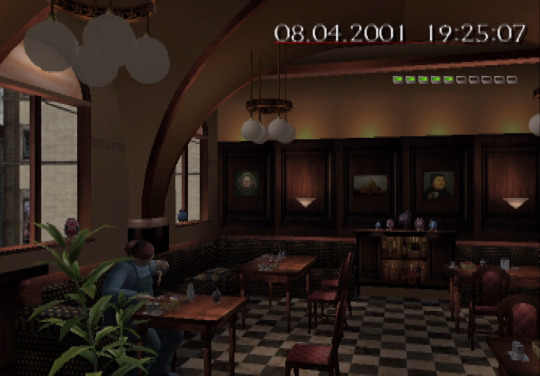
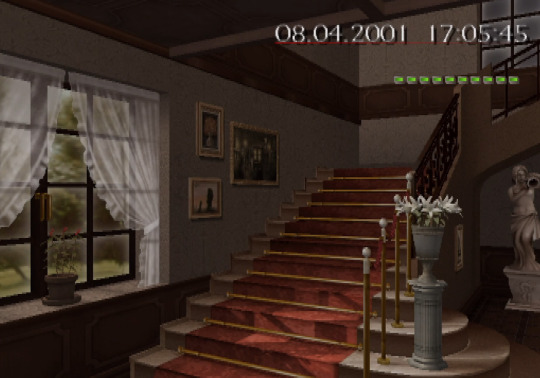
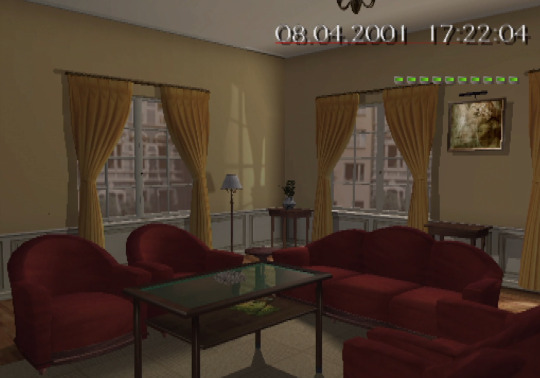

Shadow of Memories (PS2)
89 notes
·
View notes
Text
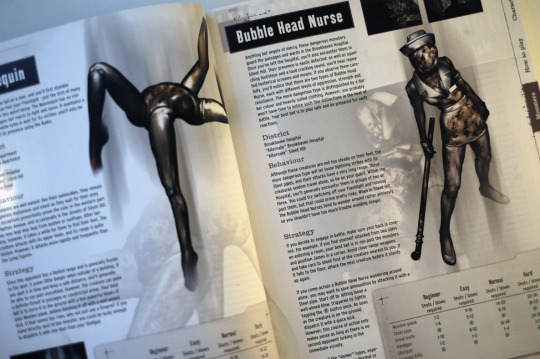
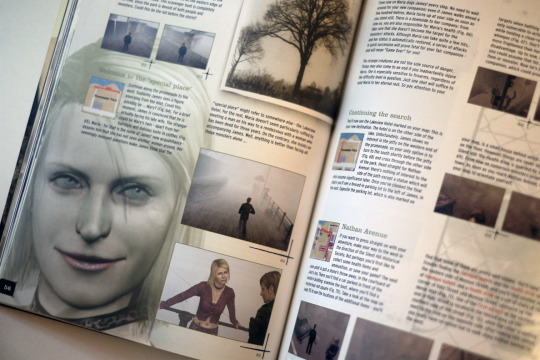
Looking through some of the Silent Hill 2 Strategy Guide today!
117 notes
·
View notes
Text
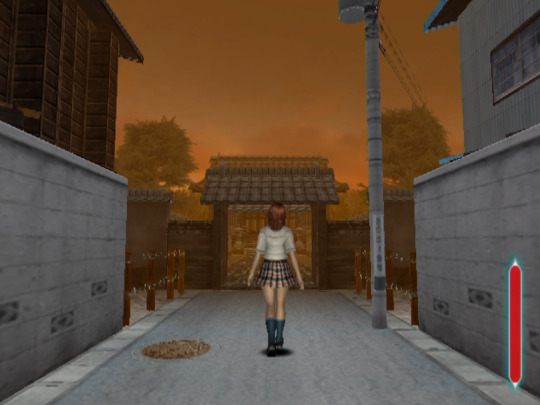




The Tairyou Jigoku (PS2) is a game in the SIMPLE2000 series, a budget line of games from D3 Publisher. Currently making a vid for this game!
60 notes
·
View notes
Text



forbidden siren ps2 :)
49 notes
·
View notes
Text
INTERVIEW WITH SAM BARLOW AND TOMM HULETT ON SILENT HILL SHATTERED MEMORIES
As part of my Shattered Memories video, I decided to try and reach out to Designer Sam Barlow and Producer Tomm Hulett to ask them some questions. And I was delighted that they said yes! I couldn't fit everything into my video, but what they shared was too interesting not to post somewhere in its entirety! HERE IT GOES:
What was it like building the profiling system and what kind of resources did you tap into? I read that professionals helped and even analysed some of the team members! What psychological test was most surprising and interesting to you?
SAM: It was a deep dive into psychometrics! Yeah we spoke with academics who had done work into eye tracking. We put the team through a battery of personality tests to have some data to work off of. I worked with a therapist who insisted I attend sessions as a patient and genuinely, in order to make things credible. The most fun (surprising!?) anecdote is that we were working off the 5 factor personality model, which is the popular one. The fifth factor of the 5 is psychopathy. But we ended up dropping that factor because we found that everyone naturally behaves a bit like a psychopath when playing a game! So it kinda skewed the data.
TOMM: My related answer - As soon as I read the pitch with the psych profiling and how it would change the game world, I instantly (if slightly presumptuously) demanded to Produce the game. This was the type of outside-the-box thinking that I felt suited Silent Hill as a brand, but could also drive it forward with new innovations that would surprise players. Management granted my request, and I made it my personal mission to protect this feature from outside meddling, and to evangelize it across Konami.
In regards to elements of the game (character appearances, dialogue etc.) being tailored to the player’s profile, were there any other features you would have liked to implement that would also change depending on the profile? Also any other things you would have liked to have affected the profile? I saw mentions of Mii data and the Weather Channel for example!
SAM: I think always it was a question of how deep we could go -- the more specific we got, the more money it would have cost! So there were compromises in terms of the number of variations. We'd go in asking for as much as we could think of and then end up compromising and picking the key ones. Could always have used more hairstyles, outfits, or set dressing! It was particularly tight on things like monster animations -- those had to be generic, but fit against any additional animation bones, say an udder -- rather than be unique to each form. The way they moved could have been a real nice differentiator.
Yeah, we really wanted to do some stuff where we pulled in the player's Mii data, or tapped into the local weather/time for their console. But all of those things ended up being things that would have possibly upset the Nintendo guidelines, so we kinda skipped over those. We wanted to find as many ways we could make the player feel seen, and add to the feeling that the Harry they were making was tied to them.
I read that when speaking to some of the developers of the original game, you sought to understand some of their goals with the first title in order to aim for those same targets in SM. What were those goals? Was there anything the developers would have liked to do for the first game (but couldn’t for whatever reason) which were then included in SM?
SAM: Hmmm, I'm not sure we spoke directly to anyone for SH:SM. I know we had access to some people at Konami on Origins, but it was slightly difficult -- a lot of the files/documentation didn't exist anymore, so it wasn't always straightforward to tap into intentions -- as well, SH:1 was kinda of a miracle and product of a very particular moment in time so I think a lot of how the original turned out was organic. We certainly wanted to make something that would feel -- in a fresh way -- like the original felt; rather than rehashing it in a way that would feel like diminishing returns. We wanted to take some of the themes of the first game, and also some of the ideas thrown out by 2 and 3, and take them to a place that was a little bit more lived in. Like there was a vibe I got when going into the K. Gordon house in SH1 that felt so real and domestic and it had a real presence... walking into a domestic living area, that atmosphere of it being abandoned, the proximity of the horror to the domesticity, the uncanny feel. We wanted to tap into that. And to remind people that it was snowing in Silent Hill 1!
Sam, was there anything you took from SM that applied to or evolved in your future games? I think I first noticed your mark the second the VHS intro started playing with a menu in the style of a typical TV interface, the use of technology as an immersive viewpoint in your other titles has been something I’ve always loved!
SAM: Yeah, clearly I have a real interface-within-an-interface thing going on! You could argue that the principal's office puzzle is basically Her Story 0.1! I definitely enjoyed the use of the frame narrative and the idea we had that 'the player is not the protagonist' -- the idea that you create tension between the main character and the player, and explore that for dramatic effect. We deliberately kept shifting POV (3rd to 1st person) and introduced time jumps to create a disconnect with Harry. Also a lot of the way the profile system worked -- vector math and fuzzy logic underpinning choices, rather than binary trees -- has been something I've used in every game since. Under the surface the way that Her Story or Immortality knows about its scenes and connects things, and plays music, etc. is all using a similar setup.
Not a question, but I adored how going into the options/quit game menu would also display that TV interface style, like Cheryl’s view was that outer layer in the narrative that gets peeled back at the end. Reminds me of the use of the screen reflection in Telling Lies in a way!
SAM: Yeah, again, I think this is clearly my thing! Creating layers *between* the player and the narrative in a way that can actually help with a kind of immersion.
I read in a few interviews that it was an important point that every player could finish the game, with some adjustments kicking in if players were struggling. Where do you think your philosophy of prioritising players getting to experience the full story over the possibility of them getting ‘stuck’ at a difficult obstacle in the game came from? Did that stem from personal frustration you have with other games? Do you think this philosophy contended with the existing SH fanbase who were used to the perhaps more unforgiving nature of survival horror conventions?
SAM: I think if you're going to give the player something 'different', you also need to balance that out with a kind of generosity. You can't ask them to meet you halfway and then keep punishing them. It's also very much a truth that the more you make players repeat things, the more you make them stuck, the more they see the illusion -- they start to see the clockwork, the seams of the experience. So it was very important to me that we help players move smoothly through this experience to properly deliver our emotional payload.
Yeah, I think there's definitely a minority who look for a very specific game template and equate difficulty/obfuscation (and the resulting padded game time!) with the kind of survival horror experience. I don't think Shattered Memories was a game for them, in that sense. For me it's all in service of engaging the player. Sometimes challenge can do that. But the classic survival horror template definitely can also take that too far.
I read that Cold Heart turned into SM as Konami had greenlit a SH1 remake, although SM was a reimagining instead. As a result, there seemed to be a little disconnect between the marketing and what the game actually was. What were some of these differences?
SAM: I guess if there was a disconnect ultimately it was that there were probably high up bosses who thought this was a very traditional remake (just with Wii controls?) rather than a reimagining. That was something that I'm not sure was ever run all the way up the chain! But I think generally marketing got that aspect -- we would reference Battlestar Galactica and they liked that comparison. Really the big disconnect was that we'd made a game from the (new) Wii audience and most of the marketing went into positioning it as a 'gamer's game on the Wii.' That was a real missed opportunity to be honest.
What were some of the challenging aspects of making a reimagining with existing characters as opposed to brand new characters? Were there some advantages even?
SAM: I think it was all upside for us. It's great to have something to start with that you can then springboard off of. And a lot of the intent of SH:SM was that we would create a weird Deja Vu for people who *had* played the original -- a sense of things being recognizable but also very different. That was a whole extra level of vibes and emotional responses that we could tap into. This was much more fun than, say, Silent Hill: Origins where it was all downside... there it felt like we were making fan fiction, having to embellish and add small details to an existing story that had no real spare room or need for those embellishments!
Now that there have been many years to reflect, were there any ideas that you wished made it into the game? Or anything you think would have been better to have been changed or removed?
TOMM: Late-ish in development after getting a lot of feedback and considering how consumers might react, I pitched Climax on adding an element of threat and tension to the "normal" world. Nothing like overt combat or enemies, but just something so the player wouldn't feel entirely safe. This didn't go in obviously, but I sometimes wonder how it may have changed initial reactions from players.
(still third question I hit enter accidentally) Also I wish the western releases of the game didn't have a bug making one ending harder to get than intended. That's the main regret.
I think the only other SH game to have pushed the series out of its comfort zone as much as you did with SM is PT. Do you think players/critics these days are more accepting of change in their favorite franchises than they were when SM released? How did you feel when you first saw PT? Was there some specific joy in seeing the series you worked on go into a new direction like SM did?
TOMM: PT was the first (only?) SH game I got to experience after leaving Konami and I certainly think it owes something to SHSM. I'm very proud that our game was essentially a "walking simulator" before that term existed, and how favorably it compares to the notable games of that type, when we were charting our course without a map as it were. On the right day, I do think critics now are more accepting of changes and I think we owe the indie scene for that a bit. Many critics even EXPECT new titles to change up familiar elements, rather than sticking in the same molds. That said, fans are still fans. When they hear about a strange new mechanic in a series they love, I hope they remember first-person Resident Evil, Yakuza RPG, and maybe SHSM, and give it a fair chance.
SAM: Maybe? We're definitely living through an age of renewed nostalgia and backwards thinking. So many reboots and remakes! So maybe now is the wrong time to push franchises in fresh directions. Which is a shame. But outside that, I think the audience is definitely open to new experiences and the definitions of genres have expanded. P.T. was great -- I loved how it was delivered, the impact on players. To be honest, in all likelihood how things turned out was probably best? I can't imagine the full Silent Hill reboot ending up having the same impact that P.T. (and it's being lost to time!) was able to generate? I definitely appreciated the ways in which P.T. recalled some of the non euclidian domestic stuff we did in our later 'nowhere' sequence, and just that sense of immersion in a domestic space.
What do you think the legacy for SM was? Any lasting effects you feel were left on the series or community, maybe even the horror genre as a whole?
TOMM: (kind of answered a bit above but we'll try). I hope SHSM takes some of the credit for expanding what a "horror" game can be. It was pretty strict beforehand, you had your RE-style actiony games, and your SH-style atmosphere games that that's how the genre was judged. Horror games these days have such a huge range now and it's wonderful. Weird text-driven meta things, or PS1 throwbacks like Signalis. It's great. Horror only works when it surprises you, so I'm glad it all doesn't fit into 2 rigid definitions anymore.
SAM: Clearly a lot of what we did in SH:SM ended up becoming quite standard -- the flight rather than fight gameplay; the sense of open, immersive spaces with no loading; the 'walking simulator' aspects of our storytelling, etc. I couldn't say whether any of that was directly because of SH:SM, or just in the water anyway! I have heard some developers call out SH:SM, so it does sometimes feel like we had an outsized reaction from particular press, or particular groups of developers -- rather than the world at large.
Sam, this is more out of my own curiosity than anything… but I read that you saw similarities in the chase sequences and an experience you had as a child. Apparently you were in Tanzania being chased by baboons around a swimming pool?! I need to know more!!
SAM: Yeah, when we were devving the first vertical slice, I was obsessed with the swimming pool area. The size of it, the dimensions, how the enemies out to flow around it. At the same time I was pushing the animators and artists to have the enemies on all fours, and hairy! This was a challenge as it made the camera very hard to program so it could see the enemy chasing you; and hair was a challenge on that level of tech. But I kept pushing. And everyone was like, 'why is Sam so set on these ideas??' Then one day I remembered and realized it all went back to this time when I lived in Tanzania and as a 5 year old was chased around a swimming pool by a pack of baboons. My memory is the adults just watched and laughed. It was very traumatic! I was trying to recreate that trauma for the players, but after that mini closure, I relented and let the enemies stand on two feet...
What were the best/most fun parts of development for you?
TOMM: The most fun part of development for me was sharing this weird new game with so many people. Climax developed it so that the first 20-30 minutes of the game were our "Vertical Slice" which would be used to sell the game internally. So I would present this to a room full of Konami folks and make a different person answer each opening therapy question, or make key choices along the way, and I had it all choreographed so I knew when to look at a scary image, when to call a random phone number, etc. This same section of game was then used as our demo at E3 and Gamescom, and watching all those new players giggle at "Have you cheated on a partner?" or realize their neighbor was having a different path through the demo than they did... it's just great seeing an idea come together so perfectly. Climax hit it out of the park and I was glad to be a part of it.
Anything else you’d like to share? I love hearing fun little stories or memories about game development so feel free to let loose!
TOMM: My most frustrating presentation was showing the game in its alpha state to the head of Marketing. I was showing him the Memento you get from the dart board in the bar, and how you could turn it around to view it using the Wii Remote. He got really fixated on the dart board and tried convincing me we should spend the rest of development making darts playable. People lose all kinds of time in GTA playing darts and stuff. He was relentless. I kept trying to explain the player's mindset in a horror game is different than in GTA but he kept pushing. Needless to say we did not make darts playable.
SAM: Ooh, I don't know... um.... how about that the clinic where Kaufmann works was inspired by Frank Lloyd Wright's Falling Water building? I gave the artists a bunch of photos of this classic piece of architecture for how I wanted the lighthouse clinic to look. It was only when someone then pointed it out to me that I learned the other name for this famous building? "The Kaufmann house". Mind blown.
Apart from the playable darts, were there any other odd ideas put forward outside of the team during development? Or any other instances where you had to protect the vision for SM?
SAM: I guess we were always on the backfoot in terms of not having traditional combat (or wiimote waving crowbar action) so that was one we had to keep running defense on. Mostly we were so busy executing on all the ideas we did have that we didn't really have too much time to entertain additional ideas, so we just kept moving! Stuff like ensuring that every element of the environment was readable/made sense in the narrative/imagery, etc. was something that was a real and constant effort -- the kind of detail and involvement of the narrative team across the art that just wasn't something you normally did.
A HUGE thank you to them both for participating in the interview!! You can find them on twitter:
Tomm: https://twitter.com/Hypnocrite
Sam: https://twitter.com/mrsambarlow
#silenthill #interview
44 notes
·
View notes
Text

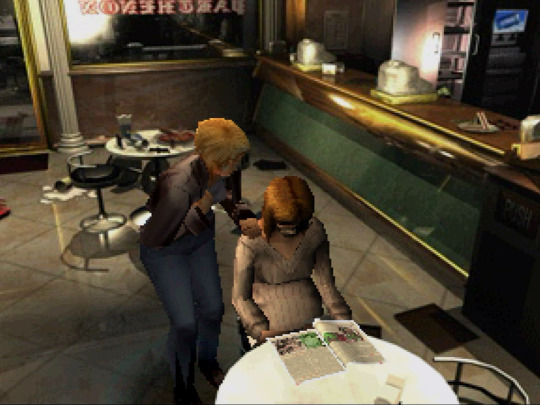

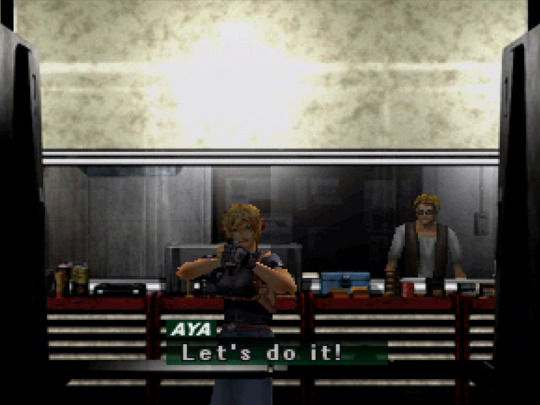
Started Parasite Eve 2 this evening xo
122 notes
·
View notes
Text
I HAVENT USED THIS SITE SINCE I WAS 16 BEAR WITH ME
27 notes
·
View notes


